Calculating when to breed your does
Daily weight gains for baby goats from kidding to weaning at 3 months range from about 1/3 to ½ lb daily in many meat goat herds although some kids can grow as slow as ¼ lb daily and some big singles as much as 2/3 lb daily. Kids from large litters will tend to grow slower than kids from small litters and kids to yearling does often grow slower than kids from mature does. Most herds count on their kids gaining about 10 to 15 lbs per month from birth to weaning and from 8 to 12 lbs per month from weaning on. It is good to know the average weight gains for kids in your herd because it can vary widely depending on breed and management.
Let’s pretend you want to market suckling kids weighing 30 to 40 lbs live for Western Easter on April 16th in 2006. We’ll assume that your kids average about 7 lbs at birth and most of your kids grow about ½ lb daily. However, your twin kids from yearling does and some of your kids from triplet litters only grow 1/3 lb daily. Goats are generally purchased and shipped to slaughter about 7 to 10 days before Easter so you want your kids to weigh 30 – 40 by April 6th. When should your kids be born?
Growthy kids: 40 lb target weight – 7 lb birth weight = 33 lbs of gain. At ½ lb of gain daily your growthy kids will need about 66 days to be ready to market.
Slower growing kids: 30 lb target weight – 7 lb birth weight = 23 lbs of gain. At 1/3 lb of gain daily, these kids will need about 69 days to be ready.
Count backwards on a calendar 66 to 69 days before April 6th to see when your kids need to be born. Apr, 6 days; Mar, 31 days; Feb, 28 days = 65 days so you want your kids born ~ Jan 27 – 31, or roughly the last week in January.
Now you need to figure out when to breed your does to get the majority to kid that week. The gestation period for goats is about 150 days so ideally you want your does bred during the last week of August. The heat cycle is about 18 – 21 days but early in the season most does will be stimulated to come into heat about 4 – 7 days after you put the buck in with them. This is called the “buck effect”. Thus, the vast majority of your herd will get bred within 2 weeks of the buck’s introduction. You will want to bring the buck into the herd by the second week in August. Greek Easter is April 23rd so you could probably sell kids that are born a week or two late during that holiday. Otherwise you may opt to put the buck in a week or two earlier especially if the buck is young and inexperienced and your buyer will tolerate some kids that are heavier than 40 lbs.
Evaluating goats for market grade and readiness
Evaluating goats for market grade and readiness is a critical skill for a meat goat farmer. There are three USDA selection grades for live goats. These grades are supposed to be based on the meat type conformation of the goat, how thickly muscled is it regardless of fat cover. Selection 1 goats should have a pronounced bulging to the outside hind leg, a full, rounded backstrip and a moderately thick outside shoulder. Selection 2 goats have moderate meat conformation while Selection 3 have inferior conformation.
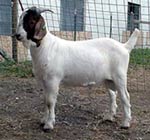
Selection 1

Selection 2
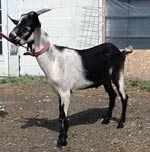
Selection 3
Some buyers will also put in a 4th grade for very unhealthy goats. Utility or “cull” goats are goats that are being culled for a serious unsoundness or appear very unthrifty.
A buyer can make a good guess at the selection grade of a goat by knowing its breed, age and weight. For example, suckling Boer X Dairy kids growing ½ lb or more daily will almost always grade Selection 1 while Boer X Dairy kids growing 1/3 lb or less will rarely make this grade.
It is difficult for weaned market kids from dairy goat breeds originating in the Alps to grade Selection 1 because their muscles tend to be very lean in appearance. Some Nubian, La Mancha and Kiko kids show more bulge to their muscles while Boer X kids and certain strains of myotonic goats such as the Tennessee Meat Goat have more potential to reach Selection 1. However, management and health are major influences on selection grade. Also even though fat covering is not supposed to be a consideration, muscles with some fat covering tend to look thicker. Selection grades do not always go side by side with customer preferences. Just because a goat is Selection 1 does not mean it will be the optimum goat for a specific market. The customer’s desires with regard for fat covering, age, sex, and carcass weight must be met.
It is important to know how your weight gains and feed costs interact. For example, if your target is to have 80 lb market kids by Christmas and your kids are born in April, it may make more sense to feed them only a limited amount of grain while raising them on summer and fall pasture than to go ahead and push them. Savings in feed costs may offset lower weight gains.
Market readiness depends on whether goats have reached the desired selection grade and carcass weight. It is also affected by health status. If your kids are growing slowly because of health problems it is important to isolate the problem early. Examine your kids regularly for internal parasites by checking that their eye membranes are a healthy dark pink color and not anemic and by taking fecal samples periodically. Any diseases such as foot scald or sore mouth that depress appetite may also slow growth. Corynebacterium abscesses, if on a lymph node in a hind leg or shoulder, can result in part of a carcass being condemned. Subcutaneous rather than intramuscular injections should be given to market goats to avoid bruising the muscles (meat). This is usually not a concern for injections of vitamins (e.g., Thiamine), minerals (e.g., BoSe) or reproductive hormones (e.g., lutalyse) as they are given in small quantities and cause little or no bruising. Drug withdrawal periods (the time needed after a medication or chemical is given to an animal for residues in the meat to reach legal and safe tolerance levels) should be scrupulously followed; otherwise the animal is not “market ready”.
Fat covering has some effect on market readiness. In the example below, both Boer X market kids may qualify as Selection 1. However, the kid on the left has little or no surplus fat. He may be “market ready” if he was cheaper to raise than the plumper kid and if he is being slaughtered on-farm by ethnic customers suspicious of excess fat who plan on consuming him the following day. However, he has two disadvantageous, 1) his dressing percentage and hence his carcass weight would have been better if you had let him fatten a few more weeks, and 2) his carcass lacks almost any protective fat covering and will be susceptible to cold shock when put in the cooler. Cold shock (contraction or shortening of the muscles) will toughen up the meat. He is not “market ready” if the price paid is based on hanging carcass weight rather than live weight and he is going to be slaughtered and chilled at a conventional slaughterhouse for sale to a restaurant chef putting a top priority on tenderness.
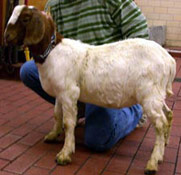
Lean kid

Carcass
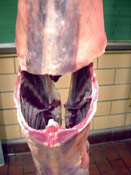
Loin
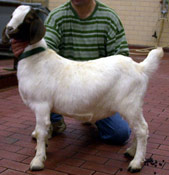
Plump kid

Carcass
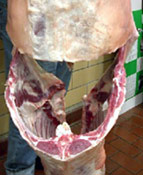
Loin
Next
Module Home
Certification Table of Contents
Browsing Table of Contents
